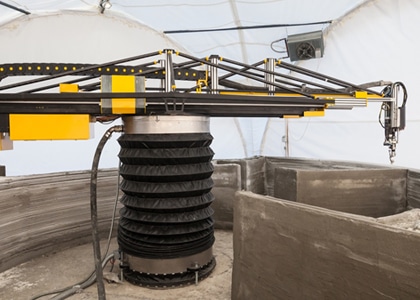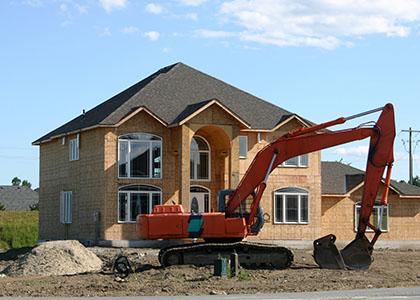Home / Blog / 5 tips to help you win more business
SUMMARY
Construction work is anything but simple—it requires the coordination and delivery of multiple factors like supplies, labor sourcing, and subcontracting. Approaching the bidding process in a linear way, where you offer a fixed profit margin over guesstimated total costs cannot work as all projects are valued differently.
You need to commit time and effort to calculating every aspect of a job so that you are not only bidding competitively but also earning repeat business while remaining profitable.
This article details tips and advice on how you can differentiate yourself from competitors to win more construction tenders.
INDEX
- Be assured on what you can deliver
- Bid accurately
- Embrace technology to provide better pricing estimates
- Plan your bids carefully
- Differentiate yourself from the competition
5 TIPS TO HELP YOU WIN MORE BUSINESS
With Saudi Arabia currently riding a construction boom, the sad truth is that building work has become commoditized. As a business, you are in a constant battle to not only win tenders but also secure your profit margins against lower bidders.
However, every company owner knows that low bidding is not a sustainable financial model. By offering the cheapest pricing, you either risk project delays and failures, or operate at a loss. Instead, change direction to offer a value-first approach—one that focuses on developing a well-thought-out strategy that counts every element of a project’s requirements. To do this you need to leverage technologies that accurately estimate costs for labor, materials, and equipment so that you are delivering on time and on budget.
Listed below are five ways to bid smarter on tenders so that you can win repeat business:
- Be assured of what you can deliver
Every construction business tells prospective clients that they are experts at the job, but this is not the case. You need to back up your claims with hard evidence through previous client testimonials, certifications, and safety records. The construction industry, much like any other, works on reputation as a recommendation. When you bid for work, highlight a record of delivering on time and without accidents. To do this you need to:
- Partner with the right scaffolding suppliers: Construction companies are built on strong and reliable partnerships between scaffolding subletters, hired laborers, and material suppliers. When there is a break in the chain, entire project timelines go off track. The right scaffolding supplier can particularly make or break a project. For example, onsite accidents and structural flaws not only cause delays and added costs but also damage your reputation. Similarly, hiccups in formwork material schedules and deliveries, or the use of substandard scaffolding, can come back to haunt you. A reliable formwork supplier also ensures better estimates on pricing, onsite safety, as well as timely deliverables. As scaffolding costing is built into total project pricing, partnering with a scaffolding company that uses smart technologies to estimate requirements can help you bid more accurately and confidently.

- Demonstrate a safety record: Studies indicate that scaffolding accidents result in almost 30% of all workplace deaths. In general, any temporary access platform is considered critical equipment when it comes to safety. As these platforms are minimal by nature and are subjected to heavy human interaction on a daily basis, accidents relating to scaffolds usually lead to fatal injuries and added delays. It also pays to keep in mind that these delays not only translate into a loss of output but also lost revenue in opportunity costs from other projects you could have taken on.
- Provide industry standards certifications: Some project tenders require proof of certification before you bid. Businesses need ISO 9001 industry standards, while scaffolding should be OSHA-certified. However, even on projects that don’t specify compliance requirements, clients look favorably on businesses that have dedicated themselves to quality systems and processes. Compliance with internationally recognized standards shows potential customers that your business is committed to providing the best products and services possible.

- Bid accurately
An important part of delivering a reliable, confident bid is having a good handle on your true job costs. As an indirect cost in construction projects, scaffolding is estimated anywhere between 15-40% of total project costs. And because pricing is a big factor in whether or not you win a contract, you need near-perfect estimates, as wrong projections can cause budget overruns and onsite delays.
As mentioned above, taking the low-cost approach is not a long-term solution. You need to be scrupulous about calculating costs, and subcontractor prices can make the difference between winning a bid or losing out. Any mistakes in calculations can lead the buyer to discard your tender—so, ensure you partner with an experienced scaffolder who is familiar with the kind of specialized work required. Partner with a formwork supplier who uses modern job-cost accounting software that tracks everything from labor and materials to overheads and profitability. A company that displays professionalism throughout the tender process demonstrates value at every step.
- Partner with professionals: Experienced formwork providers use smart estimating software to track important factors like types of projects, location, equipment and labor requirements, etc. This information helps provide you with an accurate estimate on material supplies, timelines, and pricing, so that you can bid on, and allocate time, resources, and overhead costs to only those projects that make financial sense for your business.
- Use smart estimating software: Having the lowest bid doesn’t necessarily mean you’re bidding competitively, and simply increasing your bidding volume usually only wastes precious time and money. In fact, you should ideally aim for a 10:1 tender ratio for public projects. Using the right digital software can help improve your speed and accuracy by giving better estimates. Smart software programs are also better able to offer precise numbers, improve analysis by activity, phase, or other project breakdowns, standardize estimating practices and detect errors. They also help you recognize trends and criteria for previously winning bidders so that you know what qualities you need to be bringing to the table to win. Using software to track construction and scaffolding-related factors means that you’re better placed to make a bid that is more than just a number.

- Embrace technology to provide better pricing estimates
Digitalization is changing the way every industry operates, and the construction industry is no exception. As the sector booms in the Kingdom, smart construction companies are distinguishing themselves from their competition by integrating more digitalization across their entire suite of services. Embracing technology offers the following advantages:

- Boost project productivity through AR and VR: With the introduction of augmented reality and virtual reality to construction, you can now bring scaffold design to life. You can now walk your client through an actual scaffold model that is being applied to a construction site. When making a bid, showing a client what their money is buying goes a long way in sealing the deal. As customers aren’t scaffolding experts, it’s not easy for them to validate the pricing on scaffolding design or its value. The fact of the matter is that two-dimensional sketches fall short in creating a complete picture. They also make your construction company seem antiquated and not up to par on modern construction projects. That’s why leveraging tools like the following technologies can help clients ‘see’ what their money is buying:
- Scaffold Designer helps visualize scaffolding models in 3D for a better understanding of how formwork facilitates more complicated, specialized, and nuanced construction work.
- Navisworks, Revit, or Tekla Structures are software programs that are compatible with AutoCAD or BIM packages. They offer an intuitive interface to help you design complex structures at speed. They also help you plan for formwork inventories for a more accurate picture of pricing.
- Scaffold Viewer, another smart program Scaffold Viewer renders scaffold sketches into interactive 3D scaffolding for an immersive view. Not only do these technologies provide numerical accuracy for formwork materials, but they also allow you to take your design to any kind of job site and scale it to fit the building façade. Additionally, on-site, these programs alert you to potential risks within existing structures before accidents happen. Having extra visibility into scaffold erection allows you and your scaffolding provider to assess safety requirements and identify obstructions earlier. These added insights give you greater authority and confidence when it comes to bidding processes. What’s more, in the event that a client wants to make modifications to a project, with these added visualization capabilities, you can make alterations faster to reduce downtime and hazards on site.
- Embrace technology to make informed bids: Not every scaffolder is investing in technologies—and bidding with inaccurate costings is one of the main reasons why construction companies lose tenders. Professional formwork companies use smart cloud-based technologies that track finances, as well as keep to team targets.
- Plan your bids carefully
Even the smallest of mistakes can mean the difference between submitting a winning bid and missing out on a coveted and profitable project. That is why undertaking detailed planning before submitting a tender is crucial.
Some ways to plan smarter include the following:

- Track your bid-hit ratio: A bid-hit ratio is the rate at which you successfully bid on projects. It may come as a surprise that fewer than 6% of construction company owners, estimators, and project managers know their winning tender. Understanding your bid-hit ratio is a critical component of measuring the success of your bidding process. It helps you identify where you lose out on your bids, as well as evaluate your strengths and weaknesses as a company. While there is no perfect ratio to determine success, factors like who you subcontract with and the type of projects you bid on and get determine how you are seen in the industry.
- Bid on jobs that best fit your niche: If you follow your bid-hit ratios over time, you will start to see patterns in the types of jobs you’re winning. This will tell you what kind of projects you should pursue and which ones you should potentially steer clear of. Bid on jobs that best fit your niche and focus on projects where you can guarantee good results.
- Bid early and know your competition: Another way to win more bids is to step in with your tender before your competition does. To do this properly, you need to actively network in your industry through one-on-one meetings, fairs, and conferences, keeping an eye on construction bidding marketplaces, and creating an active digital profile so you can pre-emptively find jobs. To do this well, ensure that your partnerships with your material supplier and scaffolding subcontractors are strong.
- Back your claims: You may claim to have the highest first-time fix rate in the region, but statements mean nothing when you can’t provide proof. Demonstrate your safety record with client testimonials and statements. Ensure that your testimonials are relevant to the work being done. For specialized projects, highlight how your scaffolding partnership brought value to the job.
- Differentiate yourself from the competition
In line with Vision 2030, the Kingdom’s Giga projects and infrastructural developments are driving a boom in construction. In 2019 alone, 193 new construction companies were established. If you want to stand out from the milieu you need to be bidding smarter. Here’s what you need to be doing:
- Don’t bid on price—bid on value: It pays to keep a standard entrepreneurial rule in mind: value is quality divided by cost. So, work on highlighting the value you bring through the different services only you can provide. There will always be someone who is cheaper than you. You want to establish the strengths of your partnerships so clearly that whatever your competitors’ price, it becomes irrelevant. Highlight what your teams bring to the table and why they are right for the job. This is where those testimonials and references become useful.

- Break down your bid and explain ROI: There is no price for experience, but for the sake of clarity break down segmented costs to highlight procurement processes in areas like equipment allocation and material sourcing. Give your prospective client insight into why working with you is best for their project. Highlight the strengths and experience of your scaffolding suppliers, their track record and wins, and explain how the client gets better ROI by working with you. Back up your information with hard data, case studies, and examples to further validate the point.
- Differentiate your brand: When you know you have the best crew working with you, you need to highlight it. Market your teams as responsive experts who offer customization, quality control, and excellent customer service. Help customers understand why these attributes are more important than price. Provide transparency and precision to gain client confidence.
One of the mistakes building companies make when bidding on projects is that they think of scaffolding design as an inconsequential element of construction. That is, they often consider the price of the design, without considering the cost of execution. Hence, when it comes to scaffolding proposals, lower prices are often associated with higher value. In reality, scaffolding work often requires constant modification to ensure quality and safety. Partnering with an unprofessional company means that your project will be riddled with inaccurate and incomplete estimates, resulting in (unpleasant) surprises for not only you but also your customer, costly project delays, and, in the worst case, construction safety hazards.
Focus on looking past scaffolding pricing if you want creativity and expertise to be reflected across all avenues of your service. Compromising on quality for low production costs will only damage your reputation as a contractor, and you’ll suffer from hidden fees from changed orders, insufficient material costs, delays in construction work due to poorly defined scope and schedules, costly errors, and repeat accidents. These mistakes cost you more than losing out on tenders—they damage your industry reputation.
For more information on how SSF can help your bid smarter on tenders, get in touch with us.












